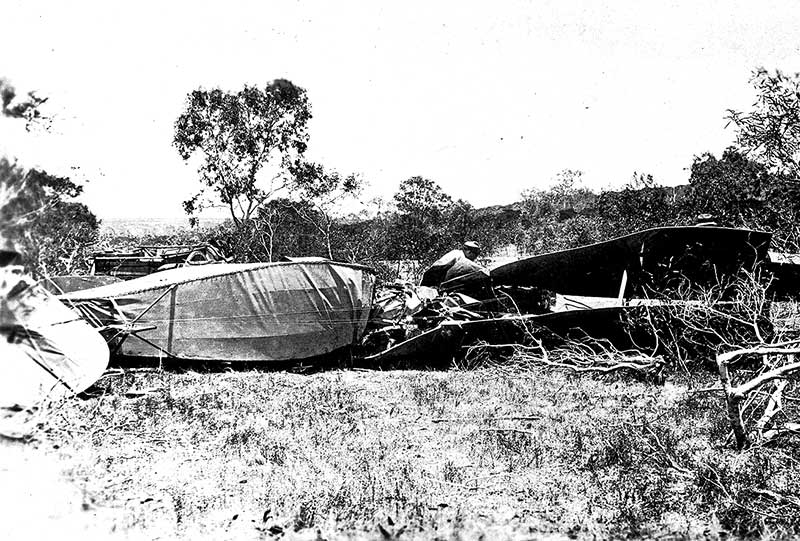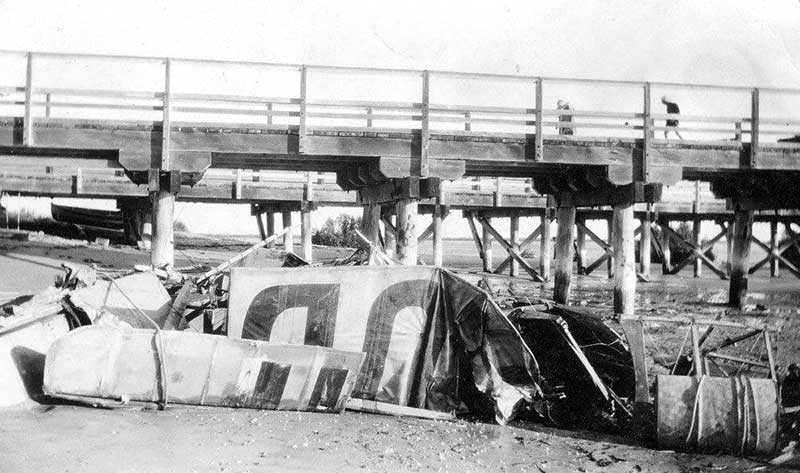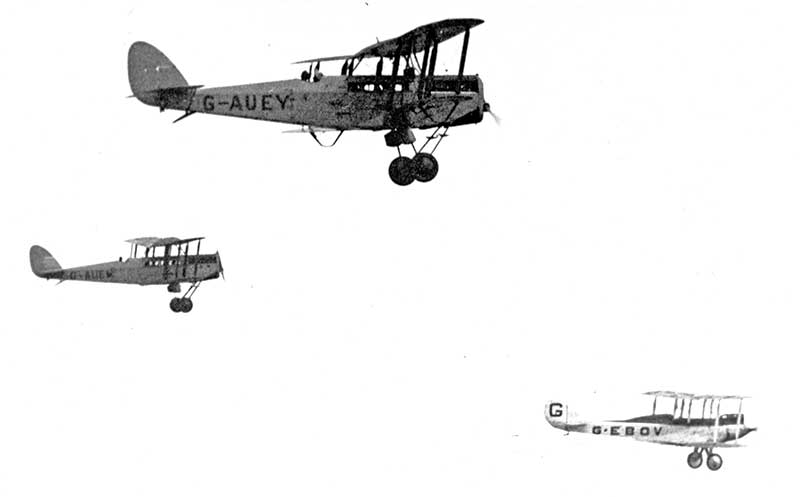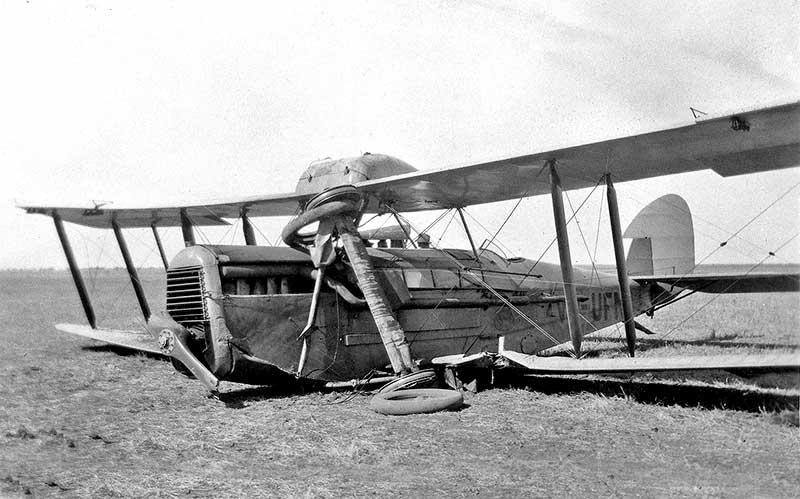Australia's first airline
A pictorial history compiled by Geoff Goodall
Photographs from the compiler's collection, some taken by WAA ground engineer Frank Colquhoun.
The majority are from personal photo album of WAA founder Sir Norman Brearley
PART ONE - THE NORTH-WEST SERVICE

A hardy passenger climbs into the two-seat cabin behind the cockpit.

Both heading photographs taken by Ernest Brandon-Cremer in September 1922, courtesy Lee Brandon-Cremer
A fatality on the inaugural northbound service from Geraldton on 5 December 1921 was a tragic start. Undaunted, Brearley got the service running to schedule over the long distances of deserted inhospitable terrain. During the 1920s WAA maintained the coastal service with increased schedules and better aircraft. In 1926 the company name was changed to West Australian Airways Ltd and in 1929 a dramatic expansion came with the introduction of the first Transcontinental air service between Adelaide and Perth. WAA proved it was a world leader by boldy importing four new DH.66 Hercules, then the largest aircraft seen in Australia.
WAA survived poor loadings during the Great Depression period, but continued scheduled services on the North-West coastal service as well as Perth-Adelaide. The company suffered a mortal blow in 1934 when the Federal Government allocation of Empire Air Mail connecting services took the North-West subsidy from WAA in favour of a small Adelaide company MacRobertson Miller Aviation Co.
West Australian Airways struggled on for two years on the barely profitable Transcontinental Service between Perth and Adelaide until Managing Director Norman Brearley and the Board agreed to sell out to Adelaide Airways in 1936. Later that year Adelaide Airways was absorbed by the formation of Australian National Airways Pty Ltd (ANA), which grew to become Australia's major domestic airline.
After the Armistic, Major Norman Brearley, DSO, MC, AFC purchased two Avro 504Ks from the Aircraft Disposals Board. He had them modified to Avro 504J standard by his own groundstaff at RAF Station Lilbourne, prior to having them shipped to Australia.
Back at home in Perth, Brearley used the two Avros for extensive joyriding in Western Australia, to raise funds for the airline he was determined to establish.

Here they are being assembled at the Belmont Racecourse in Perth at the end of that month.
Both were powered by 100hp Gnome Monosoupapes rotary engines


with an Afghan camel team, at that time widely used to carry supplies overland


Note the stitching in the fuselage fabric


A larger hangar was later constructed on the site to house six Bristol Tourers

Here before an admiring crowd at the Perth Esplanade, with Government House in the background
Brearley immediately formed Western Australian Airways Ltd and a prospectus was issued. He placed orders for 6 new Bristol Tourers plus a spare fuselage, which were basically WWI Bristol F2B Fighters modified for two passengers in a small cabin with coupe top, pilot in open cockpit, and storage compartments for mail and baggage. The engine was a 240hp Siddley Puma.
The Government sent a RAAF survey party to select airfield sites along the route to Derby, and Brearley went to RAAF Point Cook in Victoria to select prospective pilots from those answering newspaper advertisements.
The Bristol Tourers arrived from the Bristol factory on board a cargo ship at Fremantle on 20 November 1921. They were assembled at the Perth Esplanade aerodrome and test flown, in preparation for the inaugural service of Australia's first airline on 5 December 1921. The Bristols were:
Bristol 28 Coupe Tourers 240 h.p. Siddeley Puma
| Reg |
c/n |
|
| G-AUDF |
6108 |
ex G-EAXK Bristol Aeroplane Co, CofA 21.6.21 Destroyed 27.1.25 by engine-start fire Onslow WA, mail saved |
| G-AUDG |
6111 |
Sold .28 to Wilson Air Service, Sydney |
| 6113 |
spare fuselage: see UDX |
|
| G-AUDH |
6115 |
Crashed 15.7.24 Port Hedland WA. Used in rebuild of G-AUDZ |
| G-AUDI |
6116 |
Crashed 5.12.21 Murchison River WA |
| G-AUDJ |
6118 |
sold 1.27 to Charles Kingsford-Smith & Keith Anderson, Sydney |
| G-AUDK |
6119 |
sold 1.27 to Charles Kingsford-Smith & Keith Anderson, Sydney |
| G-AUDX |
6113 |
Spare fuselage assembled 3.23 at the Esplanade as G-AUDX. Sold .27 to F.T.O'Dea, Sydney |
| G-AUDZ |
6115 |
Assembled Maylands 11.24, based on wreck of G-AUDH Sold .29 to F.T.O'Dea, Sydney |


inaugural North-West air service the following day. The first WAA pilots and mechanics are assembled, including Bob Fawcett
second from left and Charles Kingsford Smith second from right.
The gentleman with coat over his arm was the airline's first passenger, Mr. M. P. Durack

They had been circling G-AUDG in which Len Taplin had made a forced landing without any damage


Photo: The Collection

Photo: The Collection
The following three photographs were taken by Ernest Brendon-Cremer, senior photographer for the Australian scientific party at Wallal for the eclipse, courtesy his grandson Lee Brendon-Cremer. Ernest's recollection was that Brearly and Kingsford Smith were the two pilots who flew into Wallal Station and also made mail drops to the scientific groups camped on the propery.




Mundabullunga Station owner Keith Mackay who drowned in the wreckage. Taplin and his engineer received minor injuries.
The aircraft remains were shipped to Perth to be used in a major rebuild which was given a new registration G-AUDZ.
Photo courtesy Lindsay Nothrop collection



Photo by Joseph McGrath, owner of Koordarrie, via Roland Jahne collection

The engine back-fired during start-up, igniting the fabric. The pilot removed all mail sacks and dragged them clear.
The loss was covered by WAA's insurance. Photo by Joseph McGrath via Roland Jahne collection

Maylands aerodrome was flooded by the Swan River in July 1926. Inside WAA's hangar, aircraft were suspended from the
rafters by cables, engines and equipment stacked above the water level. WAA's Avro 504J G-AUCL on the right.
Photo: Frank Walters collection



Mr. S. Harper of the Civil Aviation Board who was inspecting the service, was killed. Photo: The Collection

coastal steamer for return to Perth for rebuilding



The first two DH.50s arrived by sea from the DH factory in September 1924. The pair were assembled at Maylands Aerodrome and the following month entered WAA service as G-AUEL & G-AUEM on the North-West service. At the Maylands hangar, preparations got under way for the big task of constructing complete airframes to DH drawings after the airline Directors authorised expenditure to build three DH.50s and two DH.60 Moths.
As spares for the DH.50s Brearley had acquired a stock of DH.9 wings which were reconditioned to be basically interchangable. He was also watching developments in England to increase the power of the Puma engines, which was urgently needed in the high temperatures of the Nor'West. From 1928 onwards, the WAA DH.50s were re-engined with the new 300hp ADC Nimbus engine, developed from the Puma by the Aircraft Disposals Company.
| Reg |
c/n |
Type |
Reg |
|
| G-AUEL |
127 |
DH.50A |
10.24 |
Sold to Adelaide Airways 7.36 |
| G-AUEM |
128 |
DH.50A |
10.24 |
Sold to Adelaide Airways 7.36 |
| G-AUFD |
1 (WAA) |
DH.50A |
12.26 |
Crashed Geraldton WA 11.5.29 |
| G-AUFE |
2 (WAA) |
DH.50A |
12.26 |
Sold to Adelaide Airways 7.36 |
| G-AUFN |
3 (WAA) |
DH.50A |
7.27 |
Crashed Noonkanbah Station WA 20.9.31 |
| G-AUEY |
73 |
DH.50 |
4.26 |
ex G-EBFN. Sold to Adelaide Airways 7.36 |
| G-AUMC |
74 |
DH.50J |
9.29 |
ex G-EBFO. Crashed Mia Mia Station 1.3.32 |






Pilot Bert Heath is at the right with two passengers

G-AUFE again, returning to Maylands in February 1927 after a landing accident at Yallingup WA, where Norman Brearley
had been conducting joyrides at the popular Caves House Hotel. The DH.50 was quickly repaired.
had been conducting joyrides at the popular Caves House Hotel. The DH.50 was quickly repaired.



The same DH.50 circa 1930 at Maylands after a repaint and change to the new Australian VH- registration series.
Photo: The Collection
Photo: The Collection

Here he has a spot of bother at Forrest WA, but reached Perth to take 2nd place in 23 hours 24 minutes flying time.
The newly-built WAA hangar and passenger hostel can be seen behind.

Pilot J. F. Nicholas was unhurt and the fractured undercarriage had been propped up against the fuselage by the time
Frank Colquhoun's recovery team arrived from Perth. They dismantled the DH.50, moved it overland to Derby where it was
loaded on a coastal steamer for Perth, where it was soon repaired in the WAA workshops at Maylands Aerodrome

VH-UFE flying from the Swan River at Maylands in November 1931 when it was fitted with floats built by Short Brothers.
This DH.50 reverted to a landplane only two months later but the floats were then fitted to VH-UEM, and one later loaned
to the German aviator Hans Bertram to fly out his Junkers W33 after being lost and rescued in northern WA.
This DH.50 reverted to a landplane only two months later but the floats were then fitted to VH-UEM, and one later loaned
to the German aviator Hans Bertram to fly out his Junkers W33 after being lost and rescued in northern WA.
With typical WAA flair, the following Monday the new flying school commenced with 33 listed pupils and two instructors Charles Nesbitt and Stanley Brearley. The airline was prepared for these events, having just completed the construction of two DH.60 Moths G-AUFI & G-AUFK under licence in their Maylands workshops. The name Perth Flying School was adopted and the demand for pilot training soon prompted another new DH.60X G-AUGO to be imported from De Havillands.
The flying school was a success, the WAA contract being extended for another year until the Aero Club was ready to take over. WAA continued its close association with the Club, and maintained their growing fleet of Moths. From this start, the Royal Aero Club of WA became one of the most successful in the Australian aero club movement and is still operating today at Perth's Jandakot Airport.

Photo: Frank Walters collection